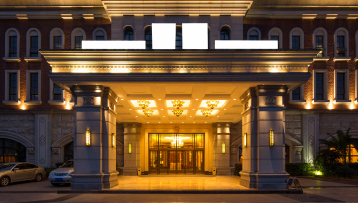FF&E – an acronym for furniture, fixtures and equipment plays a key role in the field of architecture and interior design, as it serves to form functional and attractive spaces.
Whether it’s an eye-catching open office design or creating a calm and comfortable atmosphere in an elegant hotel lobby.
The FF&E furniture interior ensures that the moving elements within the building align seamlessly with the overall vision. Understanding the FF&E process from careful planning and selection to careful hospitality procurement services and final installation is therefore critical for architects, interior designers and hospitality professionals in Saudi Arabia.
What is FF&E? (Furniture, Fixtures, and Equipment)
FF & E is an acronym for movable furniture, fixtures, and equipment that are not permanently attached to the structure of a building. And it’s a newer phrase in the interior design sector.
It encompasses any items not included in the construction package but still part of the building’s overall setup. FF&E may also be written as FFE, and FF & E.
Understanding the role of FF&E in interior design helps professionals make informed decisions during the planning, selection and purchasing stages, ensuring that all pieces align with the overall design vision and budget.
FF&E Furniture
FF&E Furniture encompasses objects designed to facilitate various human activities, including seating (like beds, stools, chairs, and sofas), dining (tables), storing belongings (dressers, cupboards, and bookshelves), working, and sleeping.
FF&E Fixture
Fixtures in FF&E are items within a property that are permanently attached to the building, or “fixed,” if you prefer. In contrast, fittings are objects that are not permanently attached to the property, except perhaps by a screw or nail. such as lighting, wall mounts, countertops and doors.
FF&E Equipment
Equipment category in FF&E encompasses technology and systems within a building, including appliances, computers, phones, fans, wiring, office furniture, electronic devices, and kitchenware.
Additional items
These decorative accents may consist of artwork, bedding, area rugs, pillows, pottery, lamps, and plants. Also include fabrics and textures used for aesthetic appearances.
These elements are key in creating environments that meet specific needs and enhance customer experiences and essential for both functionality and aesthetics in different types of spaces, such as offices, hotels, and educational institutions.
Read Also: FF&E And OS&E In Hospitality Interior Design
How Does FF&E Process Work at GHS?

The FF&E process involves several crucial steps (including planning, selection, procurement, delivery, and installation) to ensure that all elements align with the project’s vision and requirements.
Planning
This first phase involves identifying and knowing all the requirements of the project, setting a schedule and setting a budget. Understanding and seeing the client’s needs is essential to guide the entire process.
Selection
During this stage, interior designers collaborate with clients to identify and select items. They create and optimize an initial list and consider factors such as style, item specifications, budget, and lead times.
Procurement
Once selections are finalized, the procurement phase begins. This includes sending Requests for Proposals (RFPs) to vendors, reviewing proposals, selecting vendors, and arranging delivery. Purchase orders are issued at this stage.
Delivery
Ensuring that all items are delivered on time, in the correct condition, and in line with project requirements is crucial.
Installation
The final step involves installing the items according to a detailed plan, coordinating with specialists as needed.
Closeout
A final walkthrough is conducted to ensure all items are correctly placed, with any issues reported for resolution.
6 ff&e examples

FF&E, encompasses a wide range of essential elements for creating functional and aesthetically pleasingly pleasant environments. Common examples include:
- Office Furniture: Desks, chairs, and tables that provide essential workspaces in corporate settings.
- Electronic Equipment: Computers, printers, and other electronic devices necessary for daily operations.
- Kitchen Appliances: Refrigerators, ovens, and microwaves used in both commercial and residential kitchens.
- Lighting fixtures: ceiling lamps, lamps and other lighting solutions that enhance visibility and ambience.
- R&D equipment: Tools and materials used in R&D settings, such as laboratories.
- Vehicles: Vehicles and trucks owned by the company used to provide services and operating equipment.
- Office supplies: Items such as file cabinets, whiteboards, and stationery that support administrative tasks.
These items are typically movable and not part of the building’s core structure, making them integral to the functionality and design of various spaces. You can also check our real world projects from HERE.
Know More: Purchasing or Procurement in hospitality Solutions
Why Does FF&E Matter?
FF&E is crucial for several reasons, especially in industries like hospitality, office design, and retail.
Firstly, FF&E elements significantly enhance the customer experience. Thoughtfully chosen furniture, fixtures, and equipment create welcoming and functional spaces that make clients and guests feel valued and comfortable.
Secondly, FF&E helps differentiate your business. In competitive markets, unique and high-quality FF&E can set your establishment apart, making it more attractive to potential customers and retaining existing ones.
Additionally, FF&E reflects your brand identity. The style, quality, and arrangement of these elements convey your brand’s values and aesthetics, leaving a lasting impression on clients and visitors.
Moreover, FF&E is essential for operational efficiency. Properly selected and well-maintained items ensure smooth day-to-day operations, from office work to hospitality services.
In short, investing in FF&E interior design is not just about aesthetics. It’s about creating an environment that supports your brand, enhances customer satisfaction, and boosts operational efficiency.
Why is GHS considered the best company for hospitality solutions in Saudi Arabia?

- GHS is a leader in hospitality solutions due to its commitment to excellence and customer success. The company stands out by offering tailor-made FF&E interior design services that ensure that each project aligns with the client’s vision and operational needs.
- GHS FF&E expertise allows them to create functional and engaging spaces that enhance customer experiences and drive brand differentiation.
- GHS’s procurement process is highly efficient, leveraging strong vendor relationships to secure quality furniture, fixtures, and equipment at competitive prices. This ensures projects are completed on time and within budget, which is crucial for maintaining business operations without interruptions.
- GHS dedication to building long-term partnerships with clients reflects their commitment to industry-leading hospitality solutions. This focus on personalized service and quality outcomes makes GHS a trusted partner in the hospitality sector.
Furthermore, GHS prioritizes customer satisfaction by offering comprehensive support throughout the FF&E planning and implementation phases.
Have a question about interior design? Contact us for more information you need to know, or just say Hi.
Conclusion
In the world of architecture and interior design, understanding the intricacies of FF&E Furniture, Fixtures, and Equipment is paramount.
This guide has walked you through the essential steps of the FF&E process, from initial planning to final installation. By recognizing the importance of these elements, professionals can create spaces that are not only functional but also aesthetically pleasing and aligned with the client’s vision.
FF&E interior design plays a critical role in enhancing customer experience and distinguishing your brand in a competitive market. Whether you are an architect, interior designer, or hospitality professional, mastering the FF&E process ensures that every project you undertake is a step toward creating environments that resonate with users and stand the test of time.
With the right approach and partnerships, like those offered by GHS, achieving excellence in FF&E design is well within reach.
Know More about: FF&E Procurement
FAQ
What is FF&E in interior design?
FF&E stands for Furniture, Fixtures, and Equipment, which are movable items used to furnish and equip spaces. These elements are essential in creating functional and visually appealing environments across various sectors like hospitality, office spaces, and retail.
Why is FF&E important in a project?
FF&E is crucial because it directly impacts the functionality, aesthetics, and user experience of a space. It also plays a vital role in expressing a brand’s identity and differentiating it from competitors.
How does the FF&E procurement process work?
The procurement process involves selecting vendors, negotiating contracts, and coordinating the delivery and installation of FF&E items. It ensures that the right products are delivered on time and within budget.
Can FF&E be customized?
Yes, many FF&E elements can be customized to meet specific design requirements and brand standards. Customization allows for unique solutions tailored to the client’s vision and space needs.



